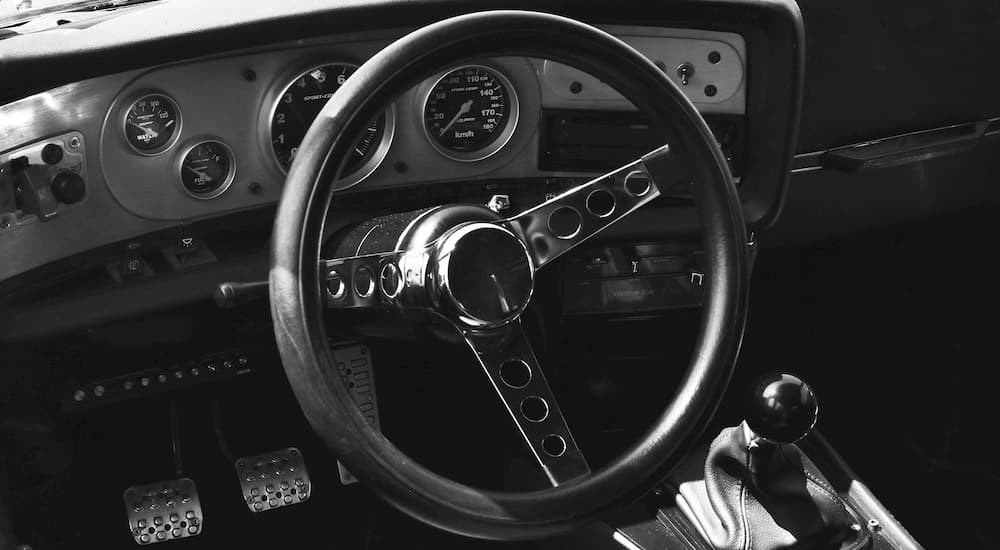Installing an aftermarket steering wheel is often an aesthetic decision, but in some cases, it can have a big impact on the overall driving experience. In fact, in certain applications, like high-performance racing and other activities common to the North American speed demon, drivers wouldn’t be caught dead with a stock steering wheel. Generally speaking, these aftermarket steering wheels tend to be aimed at the more performance-minded end of the market. We’re not saying there’s anything wrong with slapping a new $1,000 carbon fiber steering wheel on your Chrysler Pacifica. That actually might look kind of cool. But for the most part, that sort of upgrade is reserved for those who are regulars at their local track days and have their RPM shift points memorized.
The decision to swap out your stock steering wheel for a new aftermarket alternative typically comes down to three main factors: comfort, driving style, and individual preference. There are also some legal implications to be aware of when it comes to clamp-style and quick-release steering wheels for dedicated race cars, but we’ll get into that later. Read on as we take a deep dive into the world of aftermarket steering wheels, look at some of the pros and cons, and outline the features and attributes you should keep an eye on when making that wheely important upgrade.
Pros
There are many reasons to replace your standard steering wheel with an upgraded aftermarket one. Here are a few of them.
Control
While many common car modifications follow the typical “bigger is better” ethos, that’s not always true when it comes to aftermarket steering wheels. Many drivers opt for a smaller steering wheel for one simple reason: responsiveness. The smaller the steering wheel, the quicker the vehicle will react to a driver’s steering inputs, which can be a critical factor when it comes to high-speed racing and other such applications. Aftermarket steering wheels usually range between 33 to 35 cm, as compared to 36 to 38 cm for standard steering wheels, offering drivers more control and improving comfort in the typically cramped cabin of a sportier model.
Space and Visibility
That three to five centimeters of extra space you’ll experience with an aftermarket steering wheel might not seem like much, but it can have a big impact in a cramped cabin. A smaller steering wheel can make sliding in and out of the driver’s seat easier, while also increasing the space between the wheel and the top of the driver’s legs.
Those aren’t the only benefits of downsizing, either. The smaller the steering wheel, the better view you’ll have, which can make all the difference when it comes to reading the various gauges and dials you’ll need to monitor while on the track. Additionally, many aftermarket steering wheels feature a small stripe at the top. This isn’t just for looks, but to give you an easy visual reference of how hard you’ve turned into a corner. It can be easy to lose track of this during high-performance driving, especially if you’ve lost traction and are trying to regain it. This simple visual reference in your peripheral vision helps a great deal, which is why many rally drivers and drifters use it.
Service Life and Construction
Aftermarket steering wheels tend to last a lot longer than your typical stock part. They can also be easily moved from vehicle to vehicle when it’s time to upgrade to a new model. That’s an important attribute given the cost of some of today’s high-end aftermarket steering wheels, and one that makes it a little easier to justify splurging on that steering wheel of your dreams.
Looks
Finally, aftermarket steering wheels simply look cooler than their stock cousins. From vibrant contrast stitching and carbon fiber accents to flashy color schemes, finishes, and unique designs, there’s no mistaking most aftermarket steering wheels from the rather ho-hum parts that come installed on most vehicles.

Cons
As with anything, there’s a tradeoff when you replace your original steering wheel with an aftermarket one. Here are a few things to keep in mind.
Legality, Insurance, and Safety
We’ll start with the most obvious drawback of aftermarket steering wheels. They’re not as safe, and often not road-legal. Aftermarket steering wheels typically lack an airbag, which is a required safety feature in every state. The issue is even more pronounced when it comes to quick-release steering wheels, which never come with built-in airbags. There is a little wiggle room when it comes to vehicles built before 1990, but generally speaking, an aftermarket steering wheel is a non-starter unless you’re looking to build a dedicated track car. This could be a significant issue in states that require vehicle safety inspections and could give the displeased inspector just the excuse he needs to fail your car.
If you live somewhere without inspections, you still may not be in the clear, since it’s not just Johnny Law that looks down on aftermarket steering wheels. Insurance companies also have an understandable bias against steering wheels without airbags, which carry obvious risks in the case of an accident. If you disclose the installation of an aftermarket steering wheel to your insurer, expect to see a substantial rate hike, and your risk profile gets a little riskier. They may even refuse to insure you at all. Failure to disclose such a modification might seem like a savvy move, but it could come back to bite you if you’re involved in an accident and have the claim denied when your insurer learns of the aftermarket steering wheel.
Installation
When it comes to installation, aftermarket steering wheels aren’t exactly rocket science, but they’re no walk in the park, either. The job usually requires some light electrical work when it comes to disconnecting the myriad wires used to control the audio system, climate controls, horn, and cruise control, not to mention the airbag. Working around a modern airbag can feel a little bit like defusing a bomb. One wrong move, and you’re liable to set off a 200-mph projectile. When it comes to any work that could activate the airbags, we’re usually more than happy to pay a professional to put their neck on the line in our stead.
Convenience
As we touched on above, installing an aftermarket steering wheel can lead to a significant loss in convenience and functionality. With every wire you snip as part of the aftermarket steering wheel installation process, you’re losing a means of controlling various features, such as the audio system, climate controls, cruise control, and more. This might not make so much difference when it comes to a purpose-built track car but could be annoying in the long run for a daily driver.
Finding the Perfect Aftermarket Steering Wheel
Different drivers have rather different requirements when it comes to shopping for an aftermarket steering wheel. Instead of hitting you with a list of some of our favorite models on the market, we’ll take a more general approach and review some of the factors that make the biggest difference when it comes to finding the perfect aftermarket steering wheel. From diameter, shape, design, and even material, there are plenty of factors to consider when you’re in the market for a new aftermarket steering wheel.
Size
Once upon a time, a larger steering wheel was a matter of safety and convenience. Not only would they help prevent your body from hitting the windshield in a crash, but they also provided more leverage to reduce steering effort in the days before power steering. Those days are long gone. Stock steering wheels have shrunk in diameter over the years, which we can largely credit to the advent of power steering. A larger steering wheel once meant a vehicle was easier to turn, but with the mechanical assistance provided by power steering, drivers no longer need to muscle their cars through every turn. Sure, a smaller aftermarket steering wheel is still going to require a little more force than your average stock version, but unless you’re building a stripped-down race car, it’s a relatively insignificant difference, thanks to power steering.

Dish
You might have never heard of dish, but it’s quite important when it comes to finding the right aftermarket steering wheel. The concept is relatively simple and just describes the distance between where the driver holds the steering wheel and where it attaches to the central hub from front to back. Why does this matter? A steering wheel with a deeper dish will be closer to the driver than a wheel with a flatter dish, making it a vital consideration for drivers who might have particularly long or short arms. A wheel with too shallow a dish may make it difficult to turn without accidentally knocking the turn signal or windshield wiper levers.
Conversely, a deep-dish wheel will mean reaching a little further to manipulate the turn signals, lights, and other controls attached to the stalks, so take a moment to think about how often you’ll need to access these features while behind the wheel. Accessibility is another factor to consider, as an especially deep-dish steering wheel can make entering and exiting the driver’s seat into an impromptu yoga session.
Shape
The shape of a steering wheel can be just as important as dish and size when it comes to finding the right one. Aftermarket steering wheels come in all sorts of shapes, with each offering some unique benefits depending on your driving style and preferences. Most stock steering wheels tend to feature a fairly round shape, but dedicated racing steering wheels run the gamut when it comes to their dimensions.
For drivers dealing with a cramped cockpit, flat-bottom or D-shaped steering wheels tend to be one of the most popular options. In addition to lending any interior a decidedly racy look, these steering wheels go a long way in improving legroom and making it easier to enter and exit the vehicle. Open-top steering wheels are another popular option for the racing set due to the fact that the lack of a complete circle makes it easier to read the vehicle’s gauge cluster, ensuring you don’t miss vital shift points or any other relevant performance indicator. Many racing drivers tend to opt for a combination of the open-top and flat-bottom approaches, and it’s easy to see why. Lastly, there are round steering wheels. While these designs provide consistent performance and maximize grip, they lack some of the qualities that make open-top and flat-bottom steering wheels such popular choices.
These three categories are just the tip of the iceberg when it comes to steering wheel design. Spoke position, 12 o’clock position markers, and grip-enhancing grooves, pores, and contours can all make a big difference when it comes to how a car handles or a driver’s general experience behind the wheel and should not be treated as an afterthought.
Material
The material a steering wheel is made from can also have a big impact on performance and comfort. Leather or fake leather is one of the most popular choices thanks to its combination of comfort and aesthetic appeal. The material provides a solid grip and carries a certain sense of sophistication that’ll lend a classy look to any interior. That said, it can be expensive, requires some maintenance, and can become worn over time due to sun and heat exposure. Alcantara, a synthetic textile material that mimics the qualities of the suede, is another popular option that shares many of the benefits of leather.
Plastic vinyl is a great budget-friendly choice for drivers looking to save a few bucks, though it can lend a vehicle a low-rent aesthetic that can impact overall style. Those looking for a classier version of a plastic steering wheel should consider a laminated wood product which, while a bit pricer, lends the cabin an elegant old-world aesthetic.
Then there’s carbon fiber. Thanks to its unbeatable combination of low weight and durability, carbon fiber has become the go-to choice for a number of vital automotive components, not just the steering wheel. A carbon fiber steering wheel’s weight makes it easier to manipulate, improving responsiveness and allowing drivers to forge a closer connection with their vehicle. It’s also exceedingly durable, able to withstand all the wear and tear that comes with performance driving without compromise. You also can’t discount the pure visual appeal of a carbon fiber steering wheel. That subtle, checkered-flag pattern inherent to all carbon fiber parts just screams “high performance.” It does come at a cost, however. Carbon fiber steering wheels are among the most expensive on the market, though they still offer some real value when one considers just how long they’ll typically last.
Reinventing the Wheel
A good aftermarket steering wheel can be the cherry on top of a comprehensive modification project. It’s not usually the first component to get swapped out for a flashy, high-performance replacement, but few upgrades set a vehicle apart from its stock brethren quite as well as a nice aftermarket steering wheel. There are lots of aftermarket steering wheels on the market that straddle the line between performance and practicality, but as with any modification, it’s important to be honest with yourself about how the vehicle will be used and, specifically, how often it’ll be called on to perform some performance-minded antics. If you’re a dedicated weekend racer looking to prep your ride for the next track day, replacing your steering wheel with an aftermarket alternative might be par for the (race) course. This sort of upgrade might not make quite as much sense when it comes to a daily driver unless you’re looking to make every morning commute feel like an F1 qualifying session.

